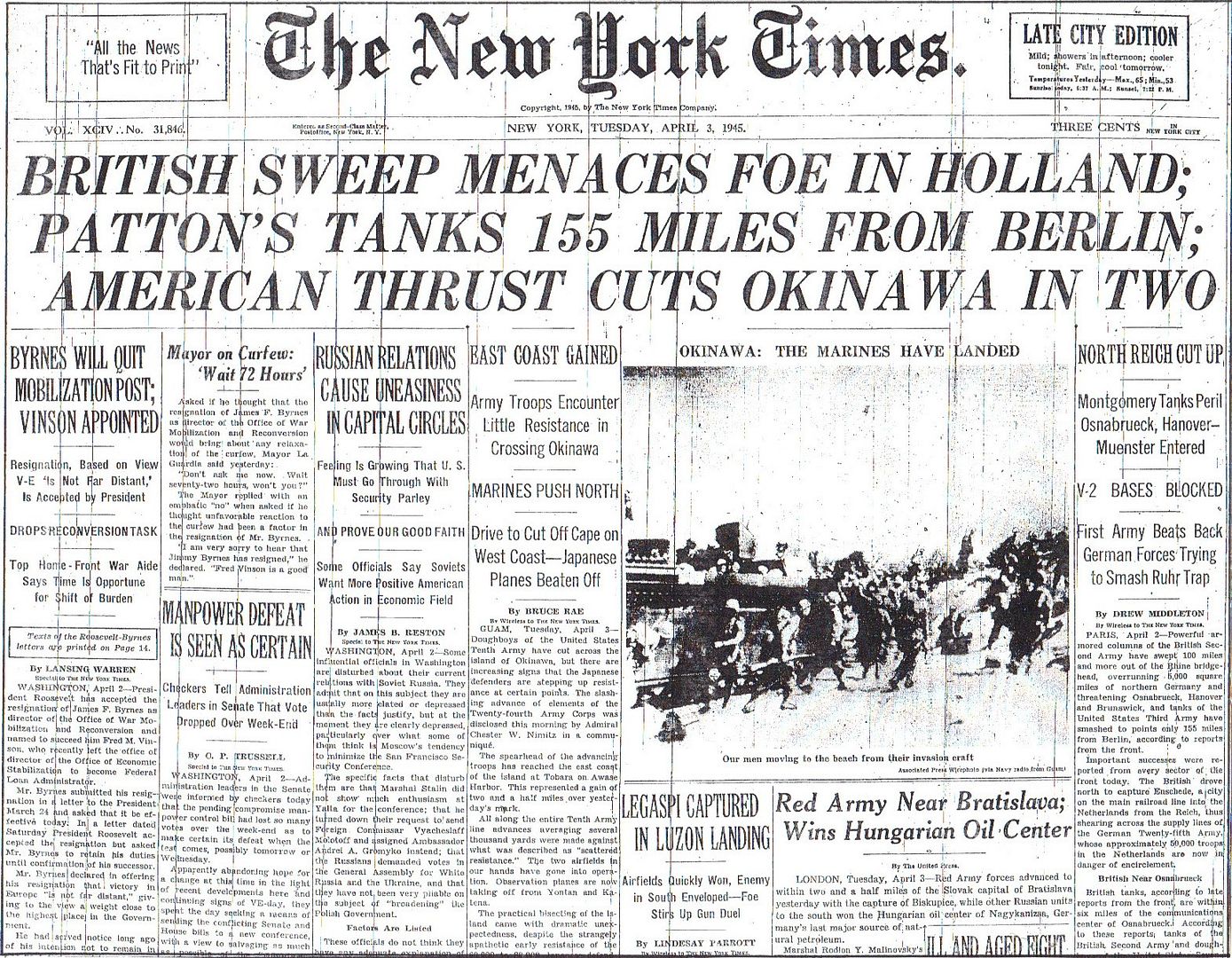
Posted on 04/03/2015 4:45:07 AM PDT by Homer_J_Simpson

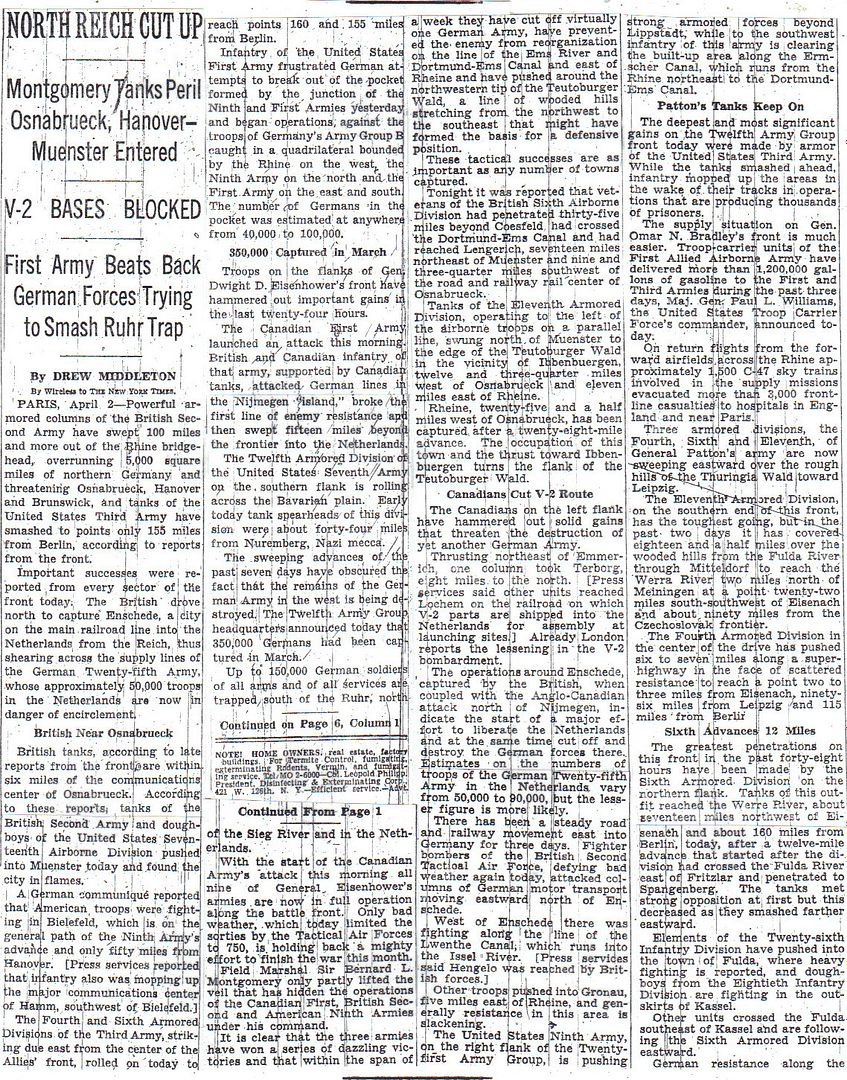
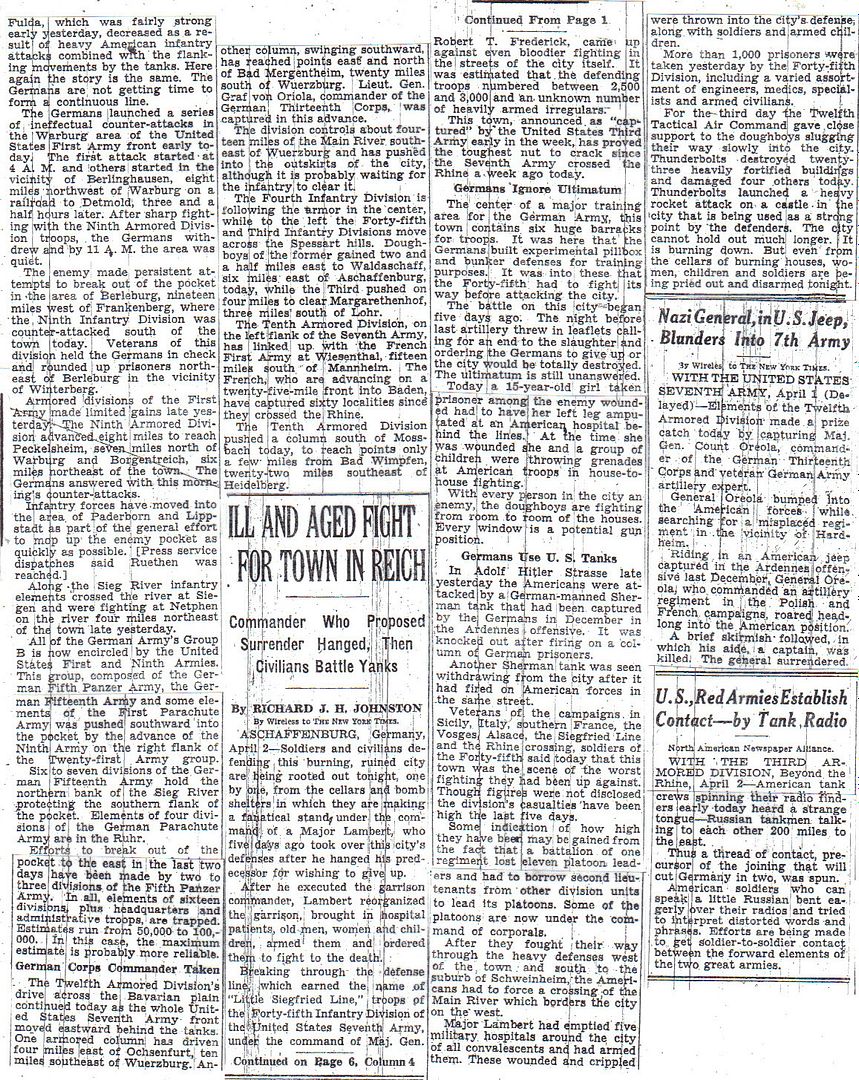
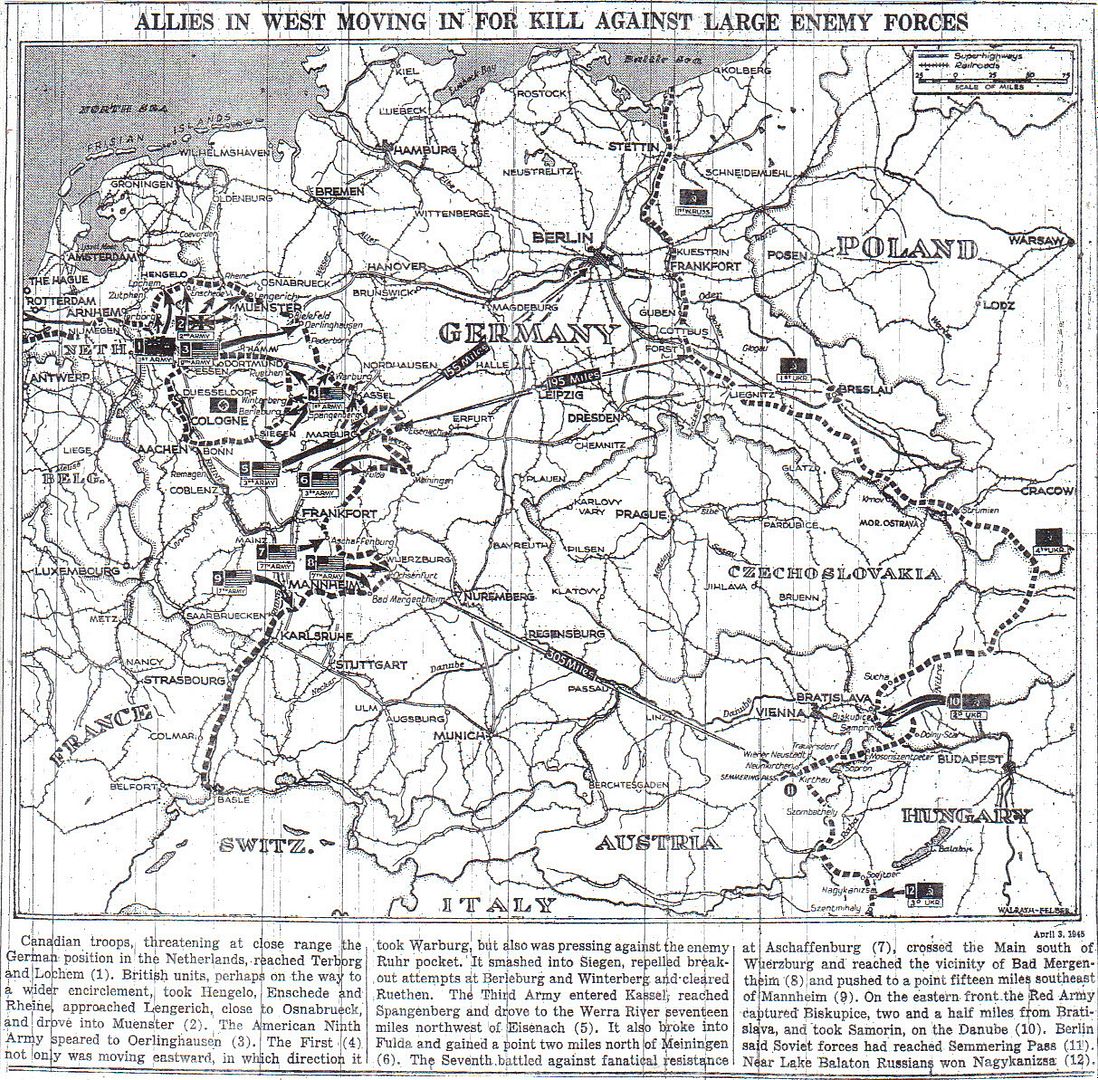
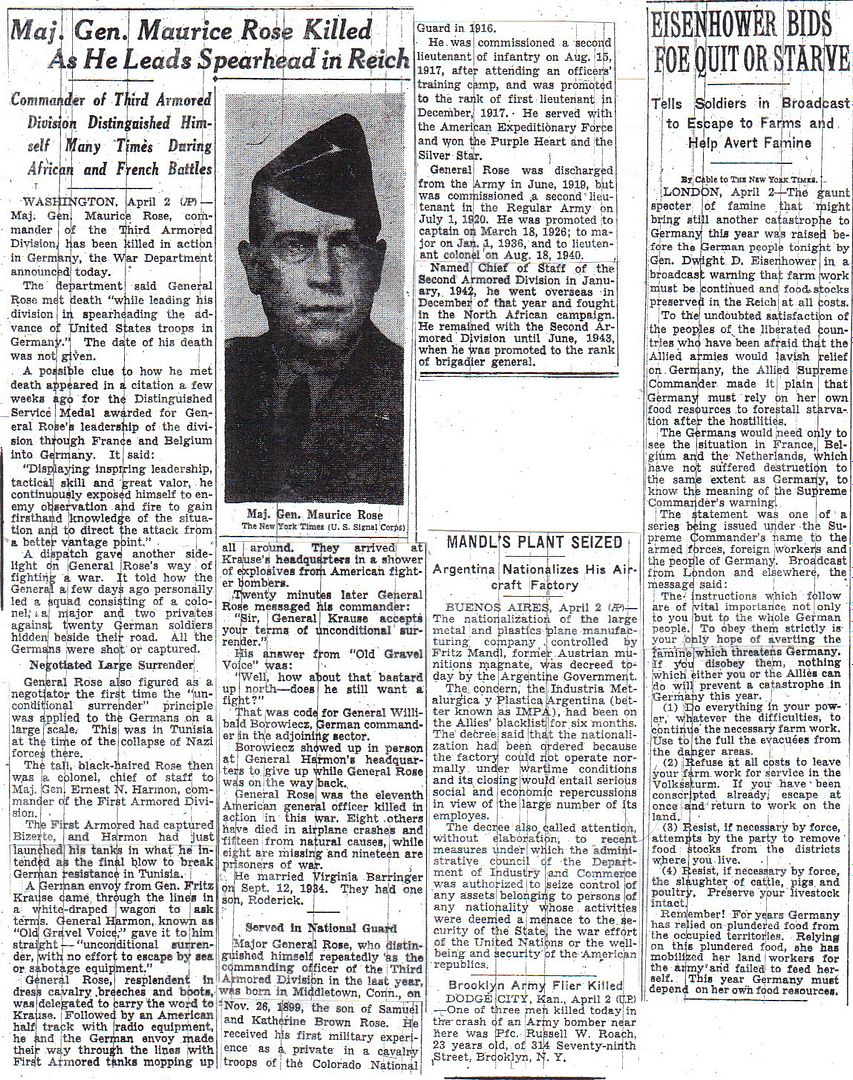

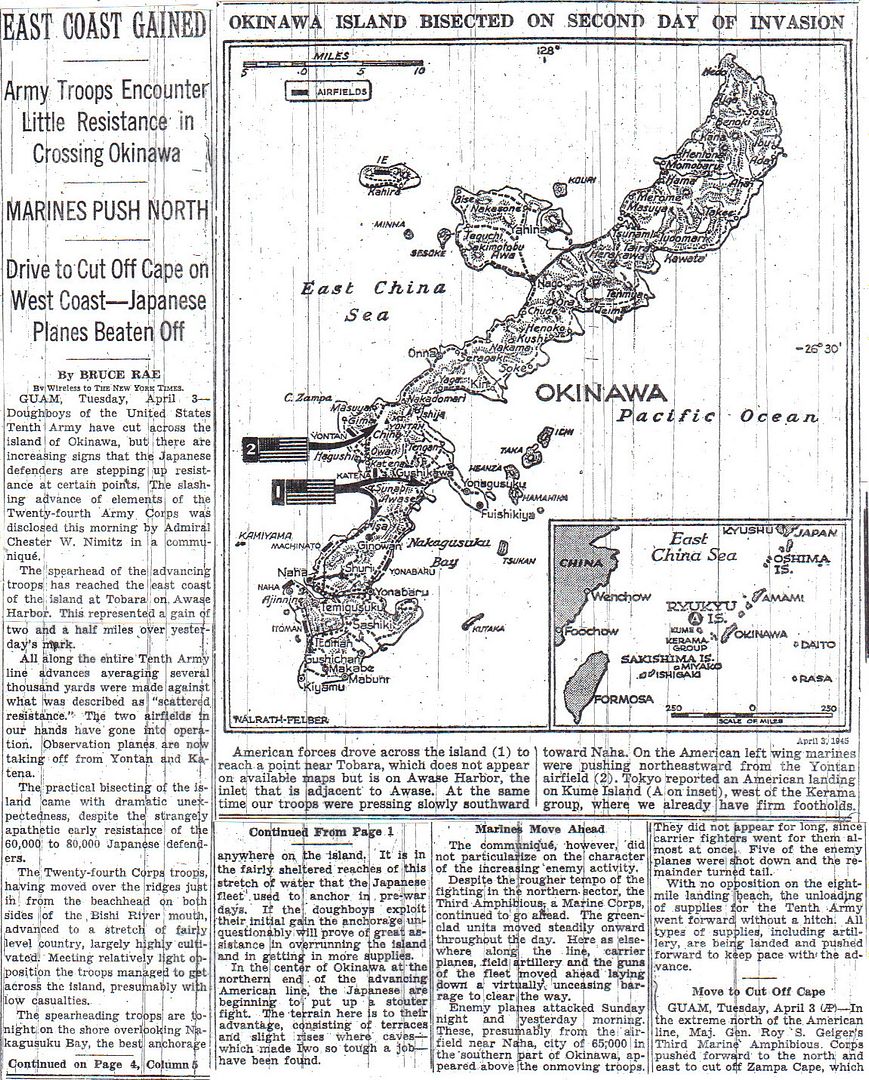
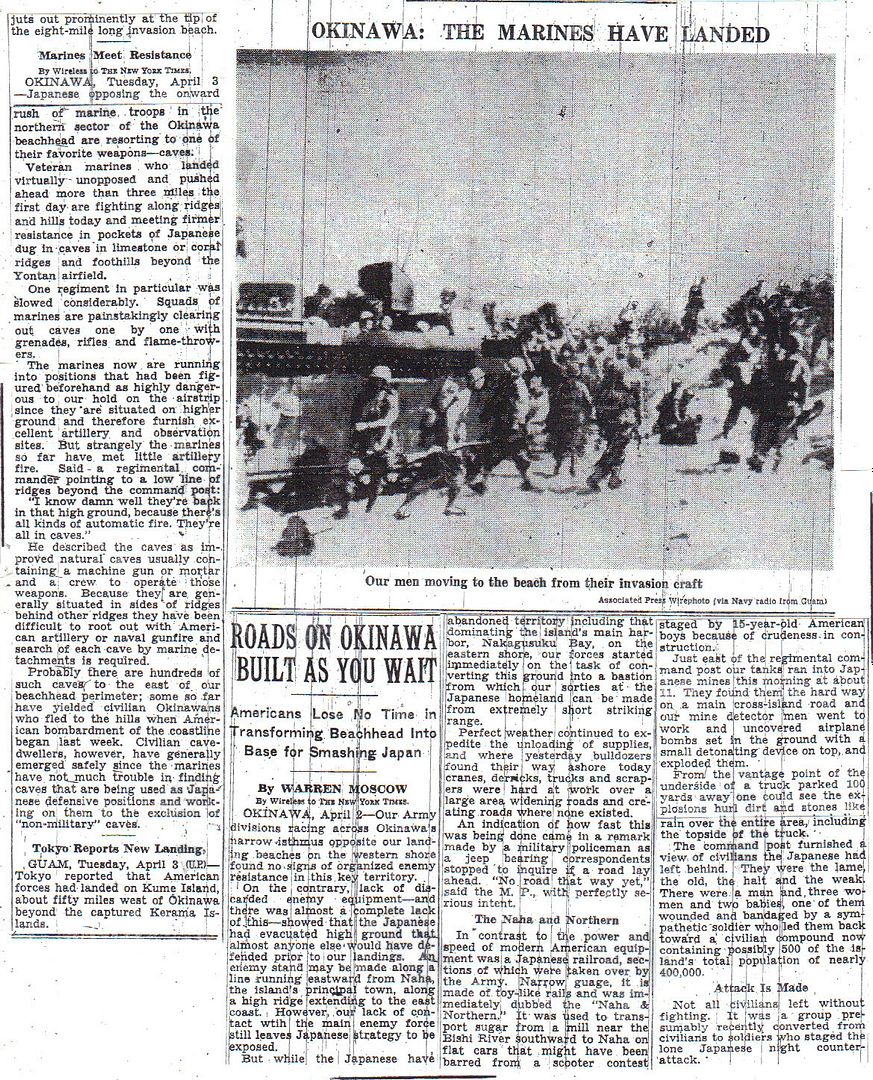
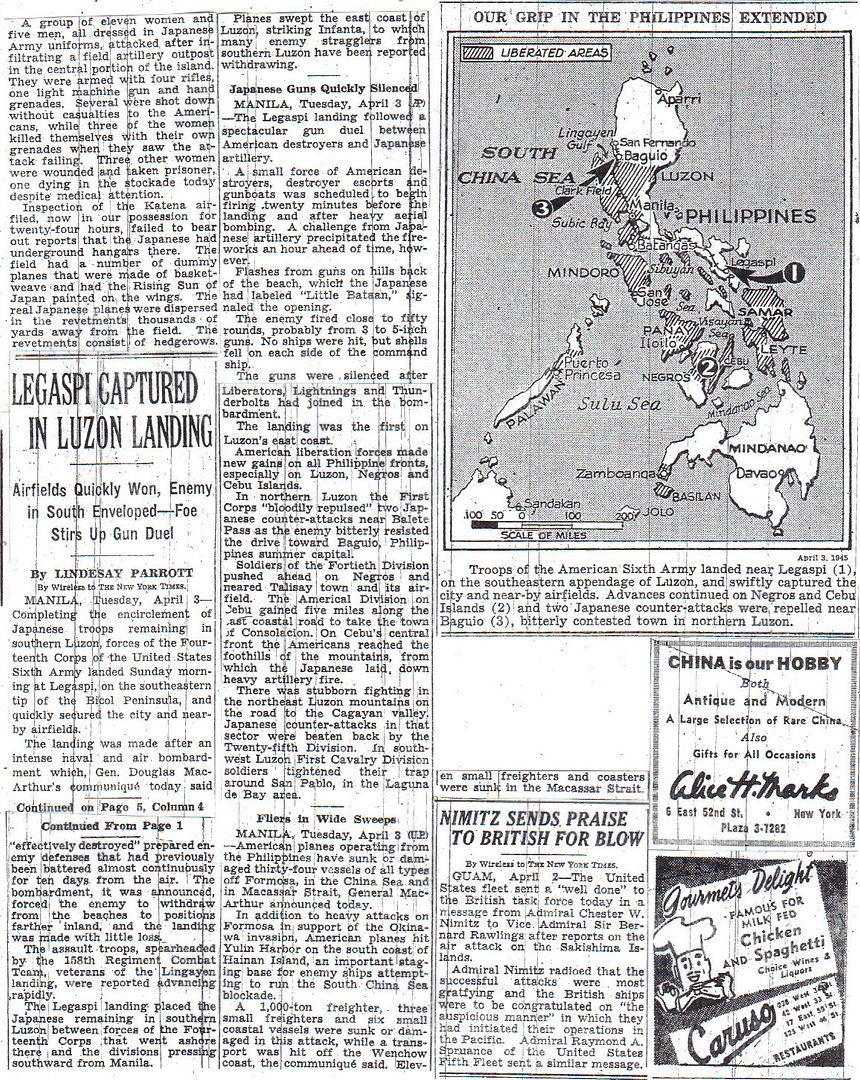
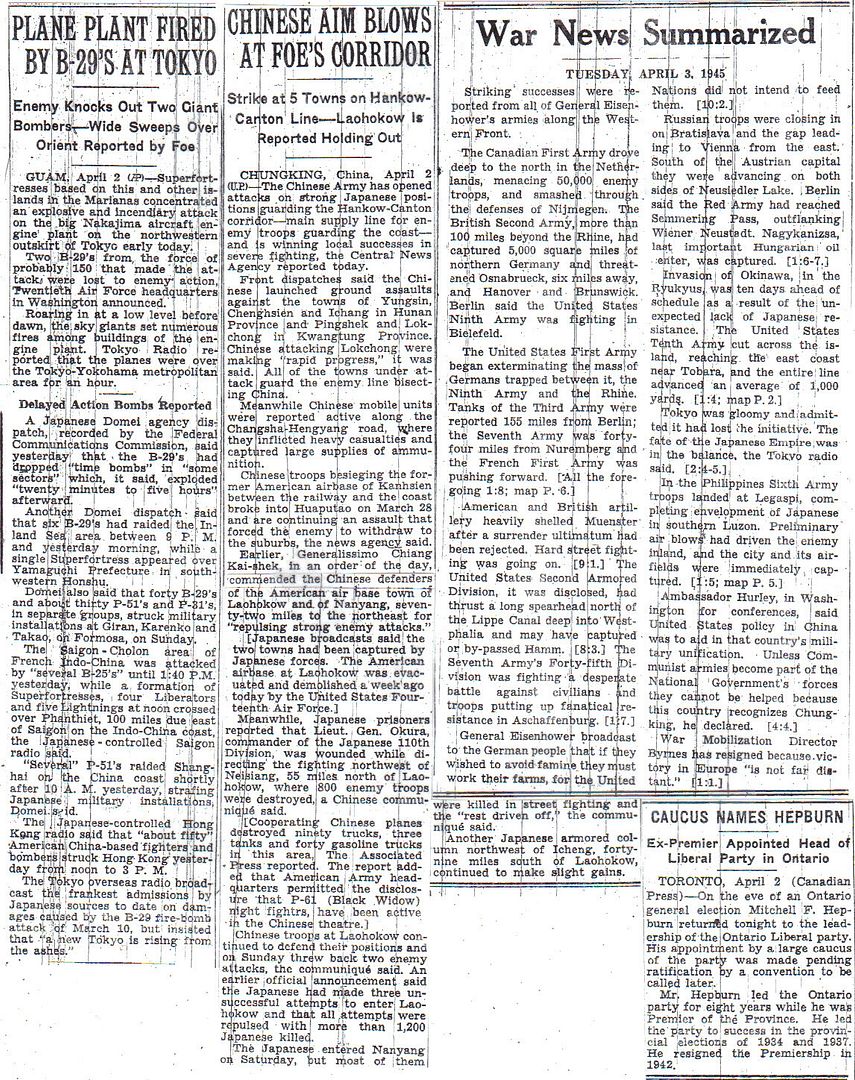
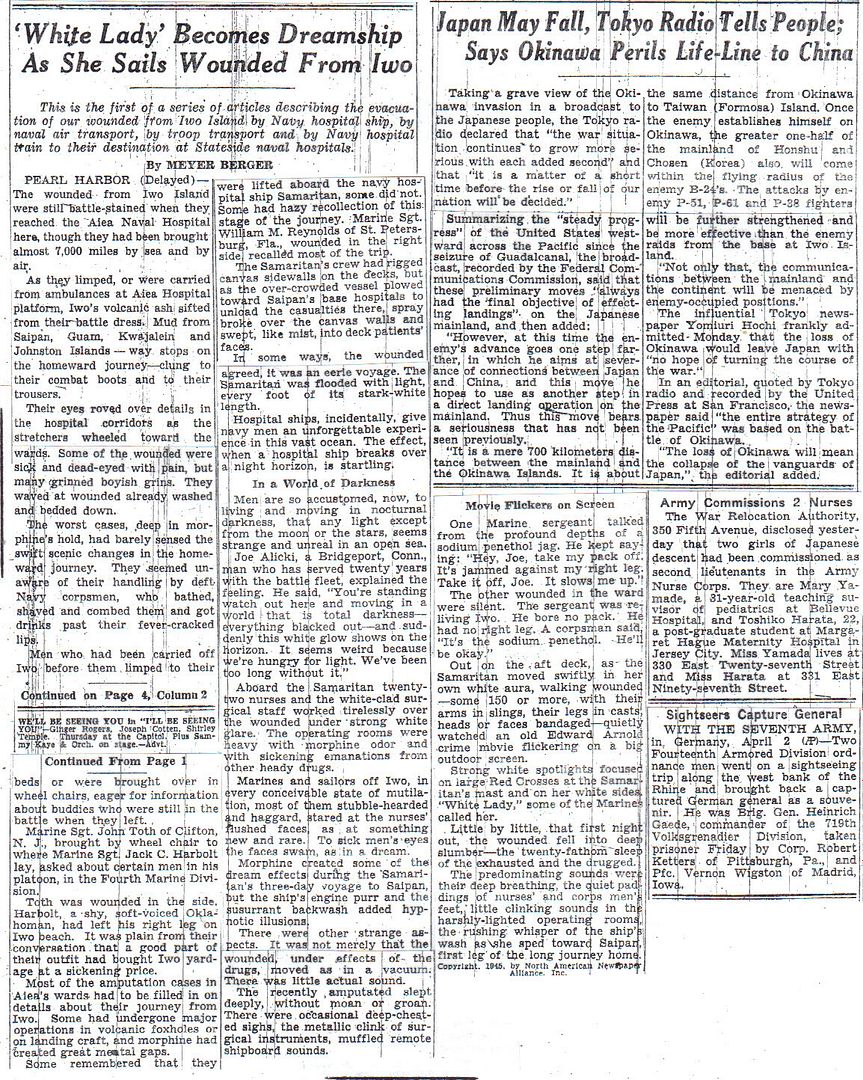
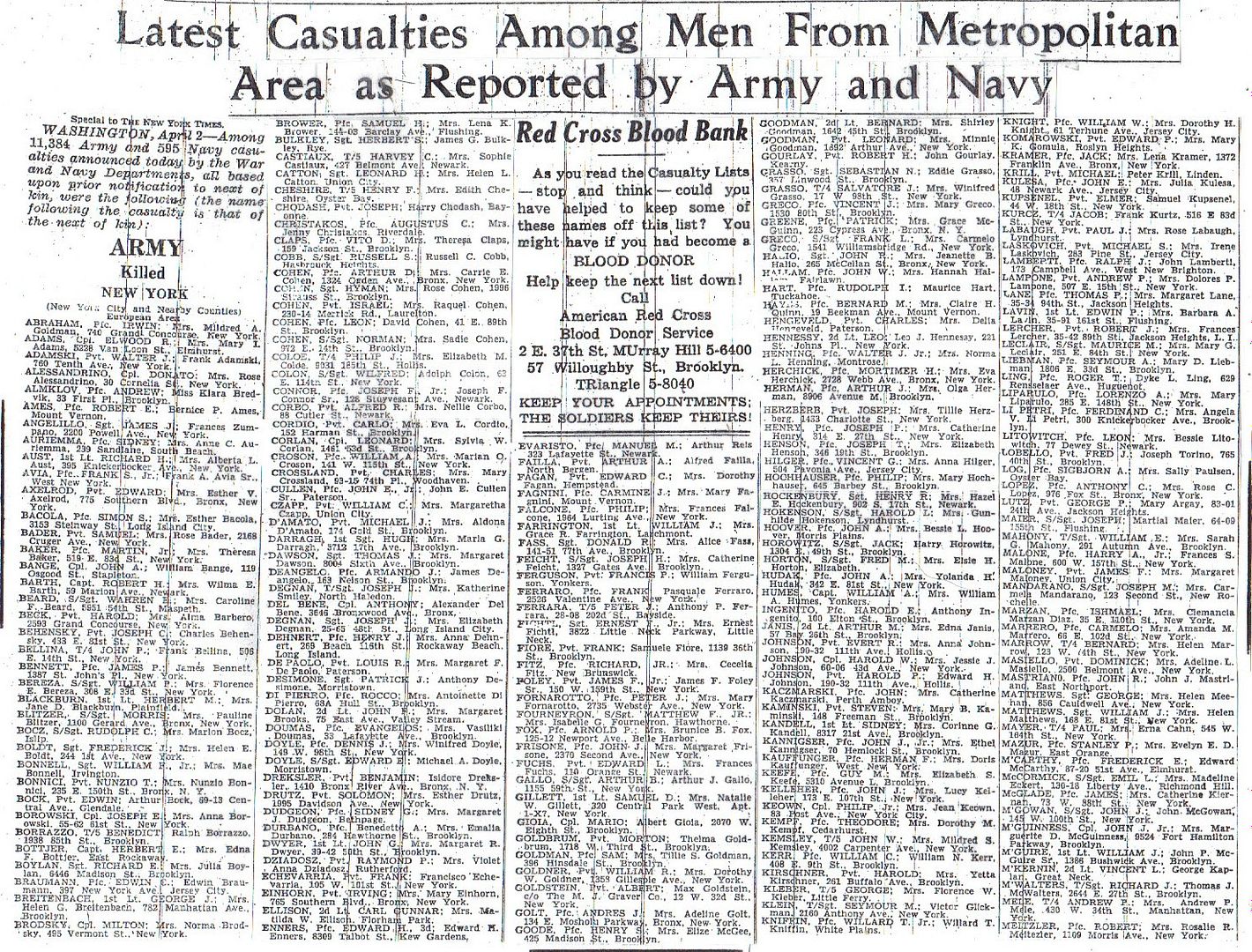
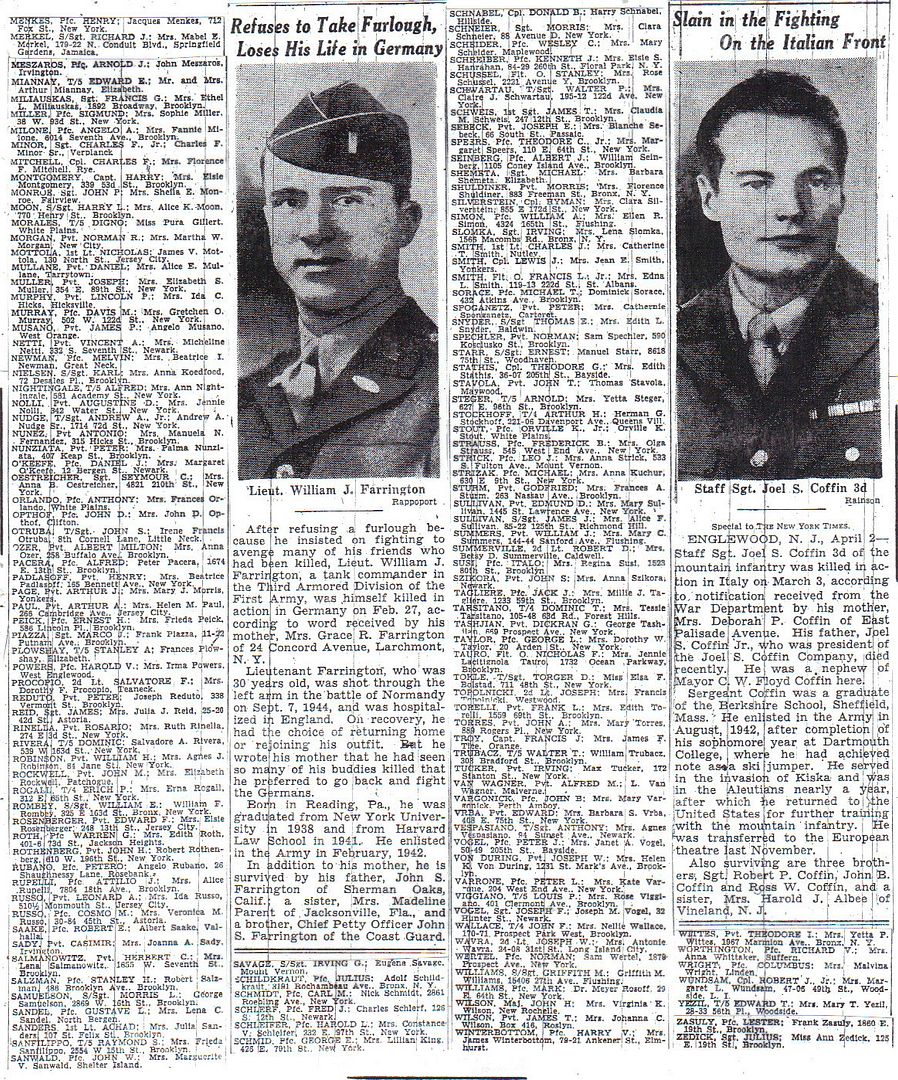
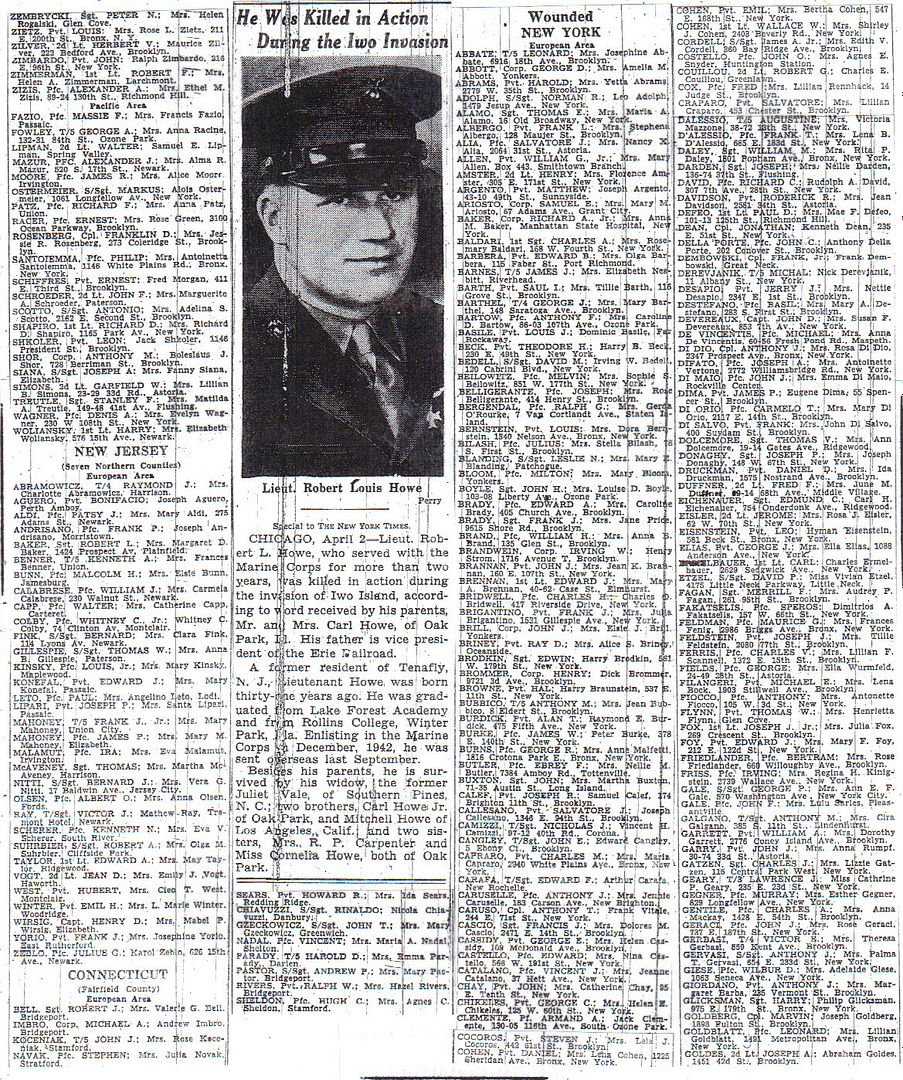
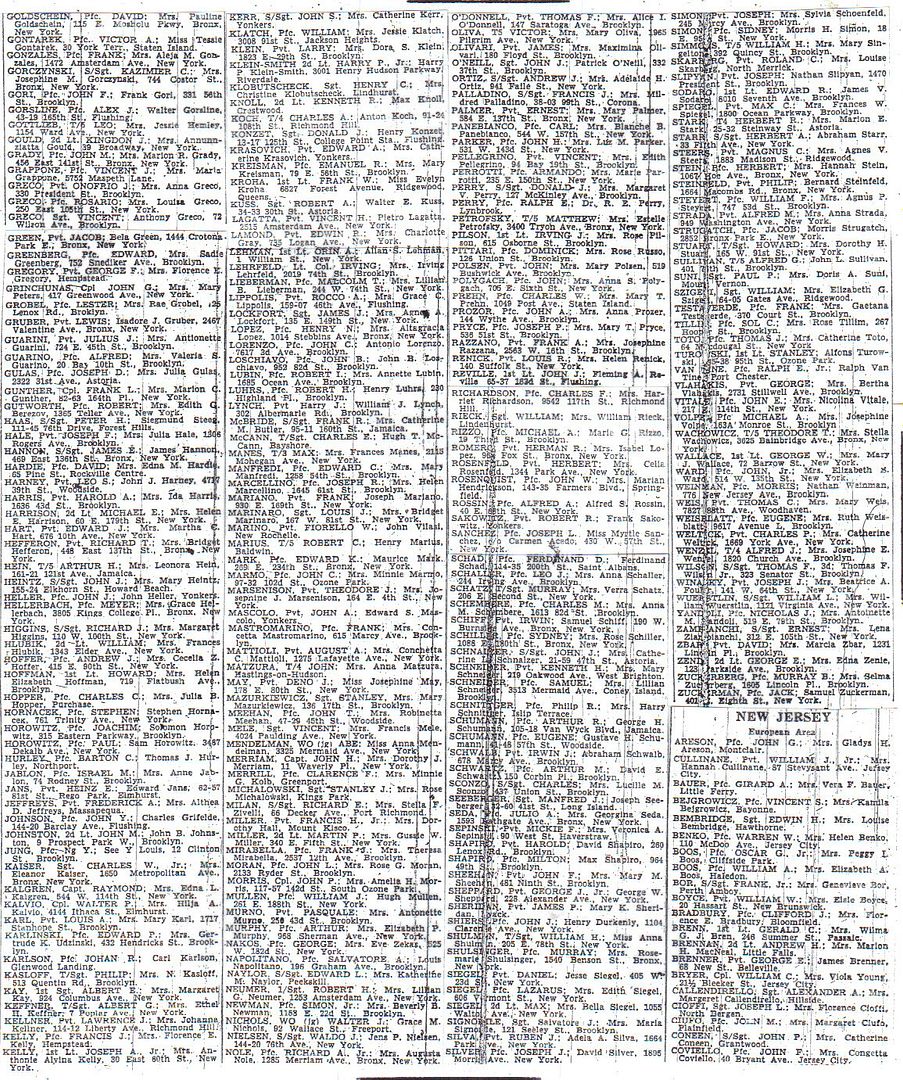


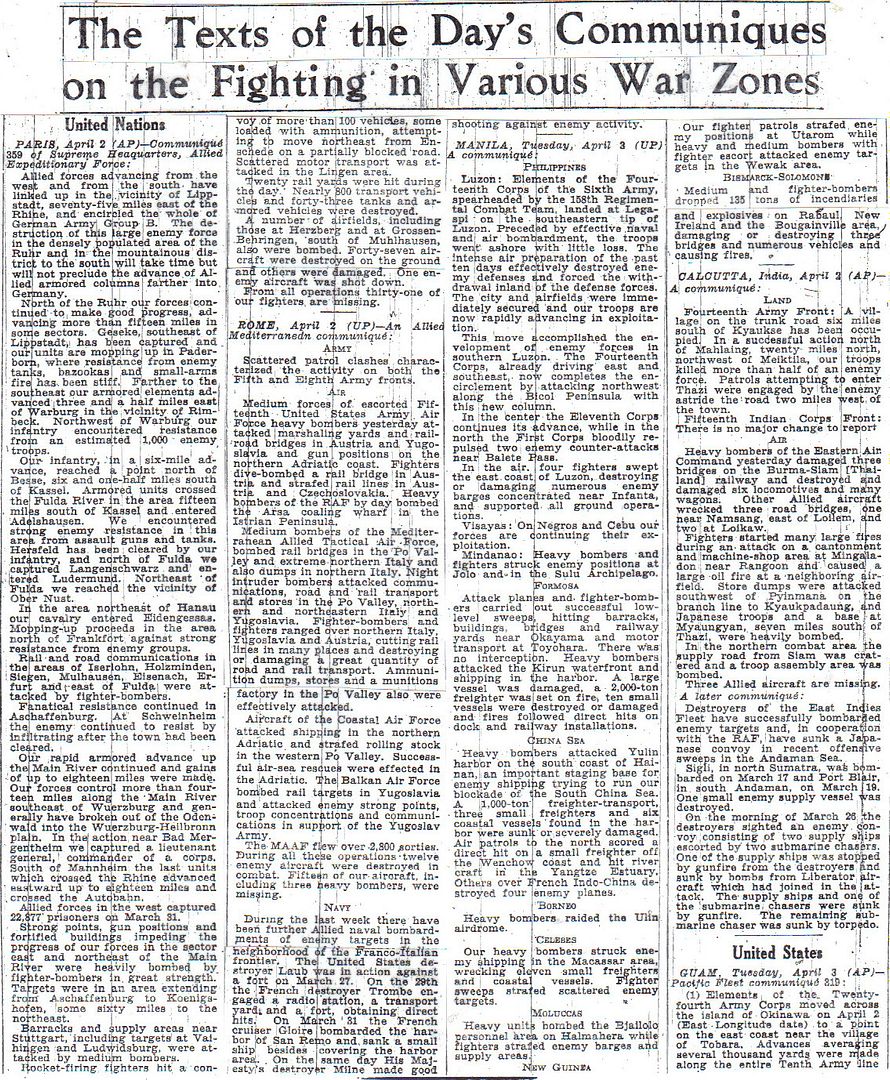
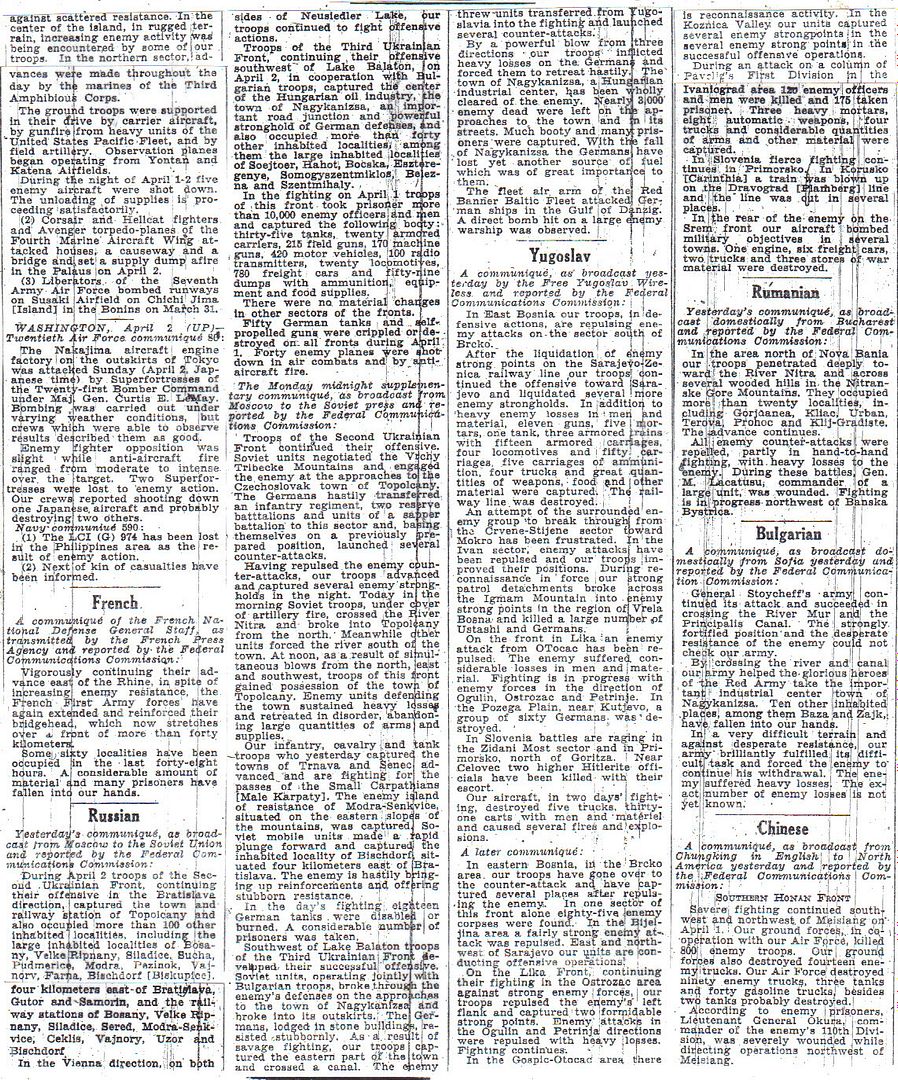
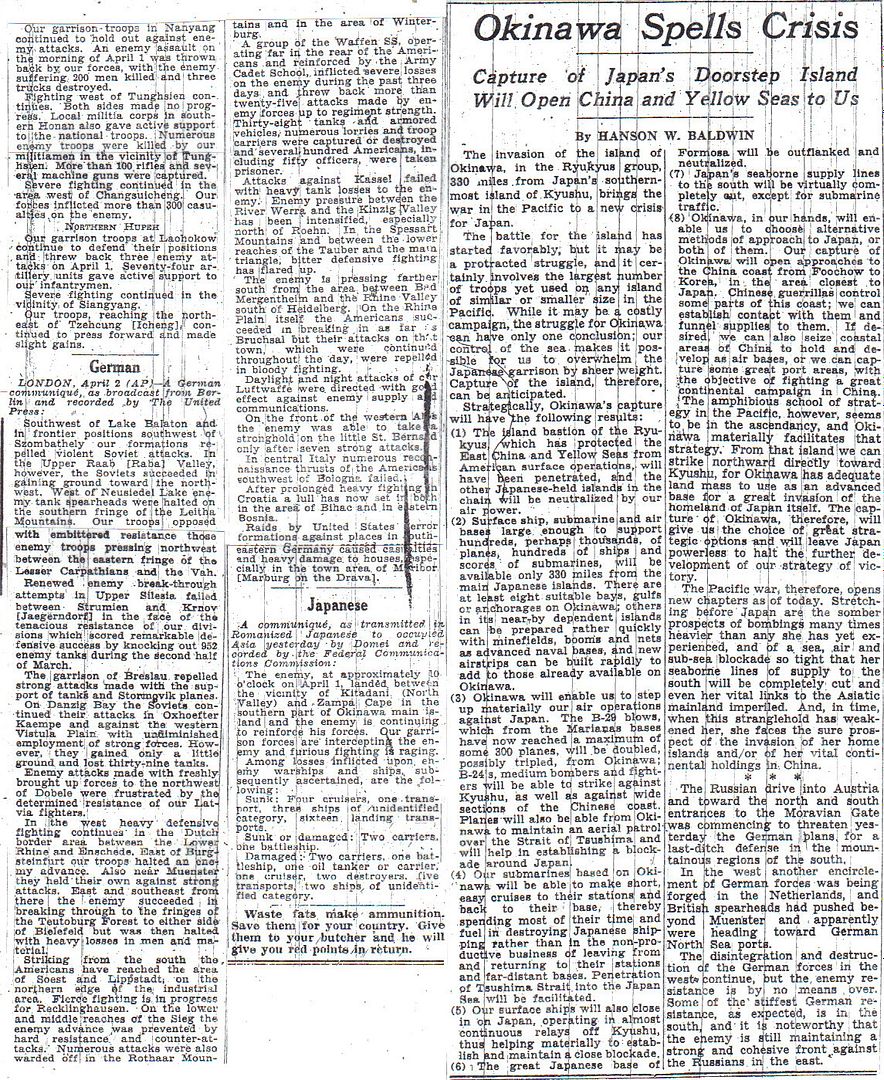
http://www.etherit.co.uk/month/3/03.htm
April 3rd, 1945 (TUESDAY)
AUSTRIA: Wiener Neustadt falls to the Soviets.
The Fifteenth Air Force, the strategic air force in Italy, dispatches 95 P-38s to dive-bomb the Tainach-Stein railroad bridge in Austria; other P-38s and P-51s fly reconnaissance and escort missions; bad weather prevents bomber operations.
GERMANY
The USAAF’s Eighth Air Force in England flies two missions:
Mission 924: 752 B-17s and 569 P-51s are dispatched to hit U-boat yards at Kiel; they claim 1-0-0 Luftwaffe aircraft; 2 bombers and 4 fighters are lost; three German submarines, U-1221, U-2542 and U-3505 are destroyed.
1. 693 of 752 B-17s hit the Deutsche U-boat yard and 24 hit the Howardts U-boat yard; 2 B-17s hit Flensburg Airfield a target of opportunity; 2 B-17s are lost and 121 damaged. Escorting are 517 of 569 P-51s; they claim 1-0-0 aircraft.
2. 98 of 100 P-51s fly a sweep of the Kiel area.
3. 4 P-51s escort an1 F-5 on a photo reconnaissance mission over Germany.
4. 17 of 18 P-51s fly a scouting mission; 2 P-51s are lost.
Mission 925: 1 B-17 and 10 B-24s are dispatched to drop leaflets in the Netherlands, France and Germany during the night.
The US Ninth Air Force, the tactical air force supporting US ground troops, dispatches about 230 B-26s, A-20s and A-26s to attack the Holzminden and Hameln marshalling yards, the town of Gottingen, 2 targets of opportunity, and fly a leaflet mission; fighters fly escort, fly patrols and armed reconnaissance, support the US 9th Armored Division in the Warburg area, the XX Corps E of the Werra River toward Muhlhausen and in the Kassel area, the XII Corps in the Gotha and Suhl areas, and the 2d and 8th Armored Divisions in the Teutoburger Forest and Neuhaus.
Capt Ian Oswald Liddell (b.1919), Coldstream Guards, scaled a road block and, in full view and under fire, disconnected the bombs planted on a bridge. He was killed on 21 April. (Victoria Cross)
The US 76th Division reassembles at Homberg to mop up German rearguard resistance. (Skip Guidry)(116)
ITALY: During the night of 2/3 April, the Twelfth Air Force, the tactical unit, sends A-20s to bomb the marshalling yard at Mantua, several Po River crossings and other communications targets in the Po Valley; weather hampers operations during the day; medium bombers cancel most missions, but manage to bomb the Po Valley bridges at Camposanto, Usigliano, and Modena; the XXII Tactical Air Command [including Brazilian and South African Air Force (SAAF) units] blast communications, fuel dumps, methane plants, trains, motor transport at numerous points in northern Italy (mainly in the Po Valley), including Parma, Modena, Fidenza, Lodi, Bergamo, Reggio Emilia, and Piacenza.
CHINA: 37 Fifth Air Force B-24s again attack the Hong Kong docks sinking two cargo ships and damaging an escort vessel; other B-24s and B-25s hit the airfield, butanol plant, and railroad yards at Kagi, Formosa while A-20s sweep other rail targets. B-25s attack N Hainan Island.
17 Fourteenth Air Force B-25s bomb the Pinglo railroad yards and 60+ fighter-bombers knock out bridges at Hsitu and between Chuting and Hengyang, destroy pontoon bridges in the Kanchou area, hit Yangtong airfield, and the Tayu, Hankow, Kanchou, Yoyang, and Ishan-Hwaiyuanchen areas.
BURMA: Bad weather again causes cancellation of most scheduled strikes; a few Tenth Air Force fighter-bombers hit a Japanese-held wooded area near Kenglong; transports complete 383 sorties to forward areas.
FRENCH INDOCHINA: 28 Fourteenth Air Force B-25s attack the Ninh Binh railroad yards, knock out a bridge at Thinh Duc, and damage bridges at Gian Khau and Mon Cay. Fighter-bombers pound the Hai Duong railroad yards, and hit river traffic and other targets of opportunity at several locations including Hongay, and Cao Bang.
JAPAN: Off Okinawa, Kamikazes damage 1 CVE and other ships of the supporting naval forces.
There are a number of attacks on USN ships off Okinawa today.
1. The escort aircraft carrier USS Wake Island (CVE-65) and high-speed minesweeper USS Hambleton (DMS-20) are damaged by kamikaze near-misses.
2. Attack transport USS Telfair (APA-210) and tank landing ship USS LST-599 are damaged by kamikazes.
3. Destroyer USS Prichett (DD-561) is damaged by a bomb.
JAPAN: The Twentieth Air Force flies four missions during the night of 3/4 April.
Mission 54: 9 B-29s mine the waters off Hiroshima, Japan without loss.
Mission 55: In the early morning, 48 of 49 B-29s hit the aircraft plant at Shizuoka, Japan without loss.
Mission 56: 43 of 78 B-29s attack the Koizumi aircraft factory and 18 hit the urban areas in Tokyo as a target of opportunity; they claim 1-0-0 Japanese aircraft.
Mission 57: 61 of 115 B-29s strike the aircraft plant at Tachikawa and 49 hit the urban area of Kawasaki as a target of opportunity; 1 B-29 is lost.
USN escort aircraft carrier USS Wake Island (CVE-65) is attacked by two kamikazes. At 1744 hours, a Japanese single-engine plane plunged at the ship from a high angle and missed the port forward corner of the flight deck, exploding in the water abreast the forecastle. Thirty seconds later, a second similar plane whistled down on the starboard side at tremendous speed, narrowly missing the bridge structure and plunging into the water about 10 feet (3 meters) from the hull. The plane exploded after impact, ripping a hole in the ship’s side below the waterline, about 45 feet (13.72 meters) long and about 18 feet (5.49 meters) from top to bottom and making many shrapnel holes. Parts of the plane were thrown onto the forecastle and into the gun sponsons. Various compartments were flooded, and the shell plating cracked between the first and second decks. Other shell plating buckled, and the main condensers were flooded with salt water, contaminating some 30,000 US gallons (24,980 Imperial gallons or 113,562 litres) of fresh water and 70,000 US gallons (58,287 Imperial gallons or 264,979 litres) of fuel oil. At 1824 hours, salting made it necessary to secure the forward engine, and the ship proceeded on one propeller. Remarkably, there were no injuries; and, by 2140 hours, corrective measures had been taken, and the ship was again steaming on both engines. The next day, the ship steamed to Kerama Retto anchorage with destroyer escorts USS Dennis (DE-405) and USS Goss (DE-444) for inspection and temporary repairs. The ship sailed for Guam on 6 April.
Other ships damaged by kamikazes include the high speed minesweeper USS Hambleton (DMS-20) and the tank landing ships USS LST-599.
FORMOSA: Fifth Air Force B-24s and B-25s hit the airfield, butanol plant, and railroad yards at Kagi, Formosa while A-20s sweep other rail targets.
COMMONWEALTH OF THE PHILIPPINES: Part of the US 40th Division lands at Masbate to assist the guerrillas.
On Luzon Island, Far East Air Force fighter-bombers and A-20s hit the Balete Pass- Baguio-Naguilian area north of the Cagayan Valley supply targets, the Laguna de Bay area, and Infanta, also, Miri Airfield in Borneo, troops in the Cebu City area on Cebu Island, and targets on Tarakan Island, Borneo are bombed.
The US 108th Infantry Regiment of the 40th Infantry Division lands on Masbate Island, located west of Leyte, to assist the guerrillas fighting the Japanese.
U.S.A.: Washington: General MacArthur has been appointed C-in-C of all US Pacific ground forces, and Admiral Nimitz will command all US naval units. The old geographic boundaries of “South-West Pacific” and “Pacific Ocean Areas” are to be discarded in favour of this new command structure in preparation for the coming invasion of Japan. The joint chiefs of staff in Washington have retained direct control of the US Twentieth Army Air Force and will exercise strategic command in the Pacific theatre.
http://marshallfoundation.org/library/digital-archive/to-winston-churchill/
General George C. Marshall To Winston Churchill, April 3, 1945
1945
Publisher: The Johns Hopkins University Press
Date: April 3, 1945
Subject: World War II
Collection: Papers of George Catlett Marshall, Volume 5: The Finest Soldier
Summary
To Winston Churchill
April 3, 1945 [Washington, D.C.]
Top Secret
MEMORANDUM FOR FIELD MARSHAL WILSON:
Please transmit the following to the Prime Minister in answer to his personal message to me dated 302330Z.1
There is complete agreement on the American side with your desire to continue the momentum of Admiral Mountbatten’s present offensive to effect the early capture of Rangoon.
Mountbatten has informed the Combined Chiefs of Staff that in his opinion he will be able to capture Rangoon by 1 June. Based on this statement the U.S. Chiefs of Staff informed the British Chiefs that they do not intend to remove U.S. air resources from Burma prior to the fall of Rangoon, or 1 June, whichever date is earlier. It is our purpose to leave with Mountbatten all that he requires to secure Rangoon this dry season, but reserving the right to transfer U.S. air resources to China if Mountbatten is not in fact successful in his attempt to capture Rangoon before the monsoon. In this last case his operations in Burma might drag on indefinitely and it does not seem wise, in view of the urgent needs of the China Theater, particularly in relation to prospective Pacific operations, to make a firm commitment to leave all U.S. resources in Burma for the conduct of a campaign for such an indeterminate period of time. It is for this reason that the limiting date of 1 June was mentioned by the U.S. Chiefs of Staff, following Mountbatten’s prediction. A more recent message from Mountbatten states a necessity to retain all transport aircraft for two months after the capture of Rangoon. We have not yet been given his reasons for this long retention and we are therefore not prepared at this time to agree.
Furthermore, we are awaiting Wedemeyer’s estimate on his requirements for the preparation of five selected Chinese divisions, in addition to those trained in Burma, for an offensive operation starting between 1 July and 1 August. Wedemeyer is now en route to China.2
The U.S. Chiefs of Staff intention is to permit Mountbatten’s employment of all the U.S. resources now at his disposal which are essential to the success of his current operations in Burma.
I greatly appreciate your very generous congratulations and comment on my past relationship with the armies now fighting in Germany. I feel very remote from any part in their great triumphs, but filled with confidence in their leadership and overwhelming striking power. Our greatest triumph really lies in the fact that we achieved the impossible, Allied military unity of action.3
Document Copy Text Source: George C. Marshall Papers, Pentagon Office Collection, Selected Materials, George C. Marshall Research Library, Lexington, Virginia.
Document Format: Typed memorandum.
1. Churchill had sent a message to Field Marshal Wilson at the British Joint Staff Mission in Washington, D.C., for transmittal to Marshall. “Please convey orally and unofficially to General Marshall the following views which I hold.” The prime minister pointed out that three British-Indian divisions, which Mountbatten had wanted for the Burma campaign, were retained in Italy in order that five British-Canadian divisions be transferred to General Eisenhower’s front. “Although the prolongation of the German war has withheld from Mountbatten the three British-Indian Divisions on which all his hopes were built, he has succeeded far beyond our hopes. The Burma Road has been opened and Mandalay has been taken.” Churchill concluded: “I feel therefore entitled to appeal to General Marshall’s sense of what is fair and right between us, in which I have the highest confidence, that he do all in his power to let Mountbatten have the comparatively small additional support which [h]is air force requires to enable the decisive battle now raging in Burma to be won. It will be a terrible thing if Mountbatten has to try to go on to Rangoon with only four instead of six divisions and thus fail to achieve a victory in the campaign which will liberate all forces in Burma for other and closer action against the Japanese.” (Churchill to Wilson, Radio No. 2058, March 30, 1945, GCMRL/G. C. Marshall Papers [Pentagon Office, Selected].) For further information regarding the transfer of resources from Burma to China, see Romanus and Sunderland, Time Runs Out in CBI, pp. 224-28, 321-25.
2. Lieutenant General Albert C. Wedemeyer, China Theater commander, had been in Washington, D.C., to meet with the Joint Chiefs of Staff, and upon his return to China, sent a lengthy report to the chief of staff. En route back, he had “a series of conferences” with Admiral Mountbatten (Supreme Allied Commander, Southeast Asia Command) and his British staff members. “They all assured me that they are doing their utmost to capture Rangoon by June 1st, although Japanese resistance might delay them. In discussing air resources they indicated that they were already short of the air lift required to support the operation,” reported Wedemeyer. “I investigated their statements and learned from key Americans in SEAC that the situation was not at all as depicted by Mountbatten. The Americans stated that my requirements were not unreasonable and that I should not feel concerned about asking for the transport aircraft after June 1st for operations envisaged in China.” (Wedemeyer to Marshall, April 13, 1945, GCMRL/G. C. Marshall Papers [Pentagon Office, Selected].)
3. “Pray further give him my warmest congratulations on the magnificent fighting and conduct of the American and Allied armies under General Eisenhower, and say what a joy it must be to him to see how the armies he called into being by his own genius have won immortal renown. He is the true `organizer of victory.’” (Churchill to Wilson, Radio No. 2058, March 30, 1945, GCMRL/G. C. Marshall Papers [Pentagon Office, Selected].)
Recommended Citation: ThePapers of George Catlett Marshall, ed.Larry I. Bland and Sharon Ritenour Stevens(Lexington, Va.: The George C. Marshall Foundation, 1981- ). Electronic version based on The Papers of George Catlett Marshall, vol. 5, “The Finest Soldier,” January 1, 1945-January 7, 1947 (Baltimore and London: The Johns Hopkins University Press, 2003), pp. 113-114.
But Adolph Hitler is no longer sane. This crop along the 9th Army/1st Belorussian Front shows the mobile panzer reserves are entraining for deployment elsewhere. Hitler believes the Soviets will those "missing" forces to make their next big push on Prague, and he is stripping Army Group Vistula of its few mobile reserves to send there. You will also note the Germans can see the reinforcements pouring into this sector. The maps are getting a lot "messier" too, in the late stages of the war as the German state disintegrates.
12th AG needs a new map. This one is filled in.
Heh. Yeah.
What’s really sad is that they’ll run out of map at the Elbe.
More about General Rose;
http://en.wikipedia.org/wiki/Maurice_Rose
I thought the story was funny about the lost German General captured in a US jeep. Can find nothing more on the story on the web.
http://www.3ad.com/history/wwll/rose.section/leopold.article.htm
THE DEATH OF MAJ. GEN. MAURICE ROSE
by Paul Leopold
Website Staff
Formerly, 3AD PIO Staff, Frankfurt
[Note: “This account is based on information available to me in 1966 at 3AD headquarters in Frankfurt, plus details I later found in books and on the Internet. The biography of General Rose by Don Marsh and Steve Ossad, first published in 2003, greatly amplifies what I’ve written below. — Paul Leopold]
On 30 March 1945, the 3rd Armored Division lost its Commanding Officer, Maj. Gen. Maurice Rose, one of the highest ranking American servicemen killed in World War II. Military historians argue whether a general’s proper place is normally at the front or the rear of his troops. If action reflects opinion, there can be no doubt what General Rose thought. He led from the front so consistently that his troops used to call him “the Division point.”
Biologists have a chemical explanation for why some men (more rarely women) thrive on putting their life at risk. Rose’s soldiers would, I’m sure, have explained it as sheer guts. But they knew where that kind of guts could get you. They would wonder how many cat’s lives Rose had left after each brush with death.
They also knew Rose was a shrewd and careful strategist. Said to have a photographic memory, his grasp of situations was instantaneous, his responses as shrewd as they were bold. Though a strict disciplinarian, Rose rarely provoked resentment in his men, for they knew he was as hard on himself as he was on them.
Once, approaching a bridge which might have been mined by the enemy, Rose insisted on being the first to drive across it. This was pure theater, but it had an effect on morale — an effect which he had no doubt rapidly (and accurately) calculated. The risk must have appeared just small enough to justify going for the payoff in morale. But risk there was — and nobody said Rose had to take it.
If soldiers love a leader the more for not worrying too much about his own safety, they also respect one the more for not standing on his dignity. Rose never pulled rank. Once during the drive on Paderborn, he and his aide, Maj. Robert Bellinger, caught sight of some Germans in uniform running from the road. He told his driver, T-5 Glen Shaunce, to stop the jeep, and all three men jumped out and chased the fugitives into a nearby cemetery. Division Artillery commander, Col. Frederic J. Brown, and his driver, Pfc. A.C. Brazeal, pulled up and joined the pursuit.
Wielding tommy guns and pistols, the five — enlisted men, field officers, and a general — captured twelve of the Germans. When Cpl. James Omand, the messenger, arrived on his motorcycle he saw a sight he would never forget: the Division Commander herding a bunch of prisoners at pistol-point!
It was this sort of “gallant carelessness” and the habit of establishing his command post within small-arms range of the enemy, that allegedly earned Rose the nickname among the Germans of “the American Rommel”. And after he died, Chicago Sun correspondent Thomas R. Henry, compared him to Stonewall Jackson, declaring in his eulogy that “in Maurice Rose’s death [the U.S. Army in Europe] has suffered its greatest single loss.”
The circumstances of Gen. Rose’s death are not — and perhaps never will be — perfectly clear. The accounts of the two men who were with him are substantially consistent, but perforce obscure, as the shooting occurred on a dark country road, suddenly, and while both witnesses were diving for cover. The identity of the third witness, the German who shot Rose, was never discovered.
This is how it happened.
With his aide Bellinger, and driver Shaunce, Rose was in a jeep accompanying Task Force Welborn along a dirt road heading for Paderborn. Ahead of them in another jeep was DivArty commander, Col. Brown; behind them in an armored car, the Division G-3, Lt. Col. Wesley Sweat. Their motorcycle messenger followed behind.
Suddenly Welborn’s column was raked by intense small-arms and direct tank and anti-tank fire from both sides of the road. Cradling a tommy gun, Rose leapt into a roadside ditch. Shaunce and Bellinger dove for cover beside him. Just then one of the Task Force’s tanks in front of them was destroyed by direct fire.
Unaware of their commander’s predicament, Division officers in the rear tried to contact Rose by radio. When Division Chief of Staff, Col. John A. Smith Jr., learned that the column had been cut he knew the situation was grave; the more so when a radio message from Rose arrived ordering Col. Liander L. Doan’s Task Force to move in and close the gap. It was Rose’s last order. Minutes later he and his party became aware of German tanks closing in on them from the rear. Caught in a vise of enemy armor, their only hope was to make a dash across-country and attempt to join forward elements of the Task Force.
Under a hail of bright tracers, the command vehicles cut sharply to the right off the road and into an adjacent field. The messenger left his motorcycle and joined the G-3 personnel in the armored car. It was dusk now, and the Germans were sending up flares to silhouette the American vehicles.
Further ahead, Rose’s party turned back onto the road, heading for what looked to them like the silhouettes of Pershing tanks. But when they’d driven past the first of these one of the men noticed that it had two exhaust pipes. Pershings had only one. They were among German Tigers.
Turning back was out of the question. Safety lay up ahead with the main body of T. F. Welborn. DivArty commander Brown gunned his jeep past three of the tanks, ripping off a fender as he squeezed past a fourth. By now the Germans realized they were in contact with the enemy. The fourth tank clanged to a halt and swung sideways, in an attempt to block the American vehicles. Brown barely got his jeep through. Rose’s driver floored the gas in a desperate bid to follow him, but was caught in a wedge, his jeep pinned between the huge panzer and a tree.
As Brown looked back to see if Rose had managed to get through, he caught sight of another Tiger bearing down on him. Swerving sharply to the right, he gunned his vehicle over a ditch and cleared the road. Abandoning the jeep in the middle of a field, Brown ran for cover. “Everybody scrambled out and headed for the woods,” he later recalled, “as by now the Germans had sent up flares and their tanks were firing.”
Before Rose and his companions could scramble to safety, the top-hatch of the Tiger opened and a German soldier appeared flourishing a machine pistol. Perhaps he was one of the half-trained recruits the Wehrmacht were rushing into service in the last months of the war. He seemed excited, even panicky — possibly trigger-happy. He shouted something unintelligible.
Rose reached toward his pistol belt. The tanker shouted again, seemingly gesturing at the general’s side-arm. Can he have thought Rose was about to draw it? It seems incredible that Rose, his .45 still in its holster, would have tried to shoot it out with a man who already had him covered with an automatic weapon. Yet that must be how it looked to the other, for he suddenly fired a volley of bullets at Rose. At least one struck him in the head and killed him. Meanwhile Shaunce and Bellinger threw themselves under the tank and managed to crawl to safety in a nearby ditch.
Shaunce was lightly wounded and, after a series of narrow escapes, reached another Task Force; Bellinger spent four days behind enemy lines before being liberated. Several others got away clean; though Lt. Col. Sweat and his G-3 staff were captured and held for a month in Stalag XI-B in Fallingbostel before they were liberated by British forces.
The next day two 3rd Armored sergeants recovered General Rose’s body. It now rests in the U.S. military cemetery at Margraten, the Netherlands, where honors at the grave-site have been regularly paid by 3rd Armored Divisional commanders.
In an attempt to explain Gen Rose’s extraordinary death in combat, some have later speculated that the soldier who shot him knew he was a Jew and wanted to do his bit for the Final Solution. The Germans,of course, were well trained in race-consciousness and doubtless word had gotten around that there was a Jewish general in the forces against them. But if the tanker could identify Rose’s “race”, he must surely have noticed his rank (like Nelson at Trafalgar, Rose would have scorned to go into battle not wearing the stars he had “won in honor”). Yet the maps and codes in Rose’s jeep were found intact when his body was recovered the next day. The Germans apparently never realized they had accounted for a Division commander.
A simpler explanation seems more likely. As even a sketchy acquaintance with military history makes clear, getting shot while trying to surrender is a common occurrence in war. Panic, confusion, fatigue and inexperience probably suffice to explain the jerking of the trigger-finger.
At 1700 on April 1st (Easter Sunday), the guns of Paderborn were silenced. Before daybreak, orders came from VII Corps HQ directing a Spearhead detachment westward against the town of Lippstadt. Rose’s successor, Brig. Gen. Hickey, sent Task Force Kane on the mission. At 1530 Kane made physical contact with elements of the 41st Armored Infantry, 2nd Armored Division, Ninth U.S. Army, and thus, one and a half hours before the fall of Paderborn, the Ruhr District was encircled.
Twenty-one German divisions and several non-divisional military units were trapped in the ring of Allied forces. Between 325,000 and 350,000 POWs were taken, including 30 general officers; Hitler’s Ruhr Commander in Chief, Field Marshal Walther Model, committed suicide; and vast quantities of enemy resources were captured or destroyed. The war in the west of Germany was effectively over.
[END]
http://ldfb.tripod.com/fb.html
April 3, 1945 Stalin to FDR:
I have received your message on the question of negotiations in Berne. You are absolutely right that, in connection with the affair regarding negotiations of the Anglo-American command with the German command somewhere in Berne or some other place, there has developed an atmosphere of fear and distrust deserving regrets. You insist there have been no negotiations yet. It may be assumed that you have not yet been fully informed. As regards my military colleagues, they, on the basis of data which they have on hand, do not have any doubts that the negotiations have taken place, and that they have ended with an agreement with the Germans, on the basis of which the German commander on the Western Front, Marshal Kesselring, has agreed to open the front and permit the Anglo-American troops to advance to the east, and the Anglo-Americans have promised in return to ease for the Germans the peace terms. I think that my colleagues are close to the truth. Otherwise one could not have understood the fact that the Anglo-Americans have refused to admit to Berne representatives of the Soviet command for participation in the negotiations with the Germans.
I also cannot understand the silence of the British, who have allowed you to correspond with me on this unpleasant matter, and they themselves remain silent, although it is known that the initiative in this whole affair with the negotiations in Berne belongs to the British. I understand that there are certain advantages for the Anglo-American troops as a result of these separate negotiations in Berne or some other place, since the Anglo-American troops get the possibility to advance into the heart of Germany almost without resistance on the part of the Germans, but why was it necessary to conceal this from the Russians, and why were your Allies, the Russians, not notified? As a result of this at the present moment the Germans on the Western Front in fact have ceased the war against England and the United States. At the same time the Germans continue the war with Russia, the Ally of England and the United States. It is understandable that such a situation can in no way serve the cause of preservation of the strengthening of trust between our countries. I personally and my colleagues would never have made such a risky step, being aware that a momentary advantage, no matter what it would be, is fading before the principal advantage of the preservation and strengthening of the trust among the Allies. (Churchill)
April 3, 1945 From Gauleiter Uiberreither to Speer:
Concerning Fuehrer’s orders of March 19, I request detailed instructions as to which armament plants in my Gau are not to be destroyed under any circumstances. Since the military situation is completely fluid, a surprise enemy breakthrough can be expected at any moment ... The fate of the armaments plants in upper Styria should be determined on the basis of the military situation in the Lower Danube region, but I have no information about that. Should the hydroelectric or steam power plants on the Drau and the Mur be destroyed before they can fall into the hands of the enemy undamaged? Your guidelines are only partly applicable here, since there is no definite front line ... (Speer)
April 3, 1945 From Speer to Gauleiter Uiberreither:
According to the Fuehrer’s orders of March 30, 1945 there is to be no scorched earth. All installations and plants should be crippled so that the enemy will derive no additional military potential from them. In almost every case expert crippling by engineers will be sufficient and will fulfill the conditions stipulated by the Fuehrer. This applies to the plants mentioned in your cable. The Fuehrer’s order of March 30, 1945, was intended to eliminate the varied interpretations that could be attached to the order of March 19, 1945, and to establish his unequivocal commitment to the method of crippling. Destruction is therefore permissible only if crippling would not achieve the desired effect. In addition the Fuehrer proclaims: Work until the last possible moment. Power plants are to be crippled only.”

WWII Paris April 3, 1945
Photo showing French troops marching towards Madeline Church on Rue Royale. April 3, 1945. The newspaper article at left is from the Stars and Stripes.
Disclaimer: Opinions posted on Free Republic are those of the individual posters and do not necessarily represent the opinion of Free Republic or its management. All materials posted herein are protected by copyright law and the exemption for fair use of copyrighted works.